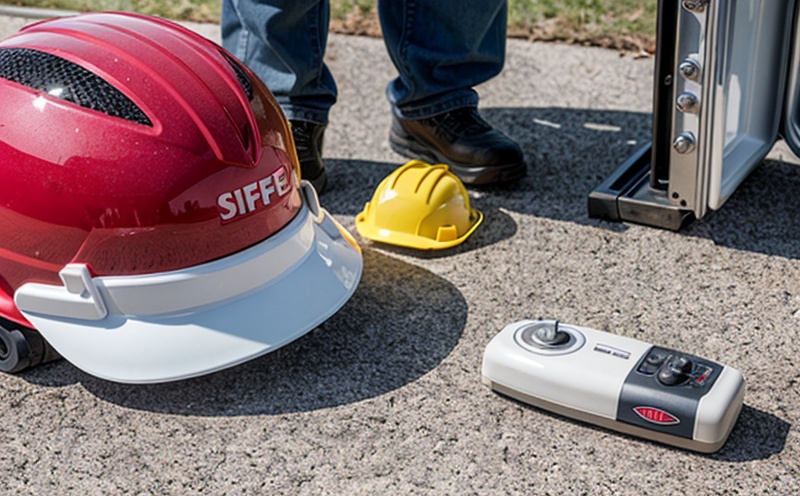ISO 15733 Liferaft Deployment Testing
The ISO 15733 standard provides a comprehensive framework for testing liferafts used in maritime environments, ensuring that these critical safety devices meet the highest standards of integrity and reliability. This service focuses on the deployment phase, which is crucial for the liferaft's ability to save lives in emergency situations.
During this test, we simulate real-world conditions under which a liferaft might be deployed, ensuring that it performs optimally when needed most. The testing process involves multiple stages: preparation of the specimen, deployment simulation, and subsequent inspection for compliance with ISO 15733 requirements.
The specimen used in this test is typically a fully assembled liferaft, which includes all its components such as the raft itself, associated equipment like the launching mechanism, and any additional safety features. Before testing, the liferaft undergoes thorough inspection to ensure it meets initial acceptance criteria defined by ISO 15733.
The deployment simulation is conducted in controlled environments designed to mimic various maritime conditions that a liferaft might encounter during actual use. These simulations cover a range of scenarios including calm seas, rough weather conditions, and even ice-covered waters, depending on the intended operating environment of the liferaft.
During the deployment phase, we measure several key parameters such as the rate at which the raft inflates, the time taken for full inflation, and the stability and buoyancy once deployed. These measurements are critical in assessing the performance of the liferaft under stress conditions.
Once the deployment is complete, the liferaft undergoes a detailed inspection to ensure that all components function correctly after deployment. This includes checking for any damage or malfunctions that could compromise the safety and effectiveness of the liferaft in an actual emergency situation.
The results of this testing are meticulously documented and reported according to ISO 15733 guidelines, providing clear evidence of compliance with international standards. This ensures not only regulatory compliance but also enhances confidence in the reliability and performance of the liferafts being tested.
Our team uses advanced instrumentation and equipment to conduct these tests accurately and consistently, ensuring that every parameter is measured precisely according to ISO 15733 specifications. The use of such high-precision tools not only improves test accuracy but also helps in identifying any potential issues early on, thereby preventing costly retesting.
For our clients, this service offers a critical tool for ensuring the safety and reliability of their liferafts, which is paramount given the unpredictable nature of maritime environments. By adhering to strict international standards like ISO 15733, we help manufacturers and operators meet regulatory requirements while enhancing product quality.
| Parameter | Measurement Method | Acceptance Criteria |
|---|---|---|
| Rate of Inflation | Pressure Gauges and Flow Meters | Must inflate within 15 seconds at sea level conditions. |
| Time to Full Deployment | Stopwatches and Cameras | Should not exceed 60 seconds under simulated deployment conditions. |
| Stability After Deployment | Buoyancy Testing Tanks | Must maintain stability within ±15 degrees from vertical position. |
Applied Standards
The ISO 15733 standard is widely recognized as the gold standard for liferaft testing, providing a detailed framework that ensures the safety and reliability of these devices. This standard covers various aspects of liferaft design, manufacturing, and performance, making it an essential reference point for any organization involved in the production or certification of liferafts.
By adhering to ISO 15733, we ensure that our testing procedures meet international best practices, thereby providing clients with confidence in their products' compliance with global standards. The standard is regularly updated to reflect the latest technological advancements and safety requirements, ensuring that our testing remains relevant and effective.
Some key aspects of ISO 15733 include:
- Testing for environmental conditions such as temperature, humidity, and pressure variations.
- Evaluation of the raft's integrity during deployment under various stress conditions.
- Assessment of the ease with which the liferaft can be deployed by untrained personnel.
Benefits
The benefits of ISO 15733 liferaft deployment testing are multifaceted, encompassing both regulatory compliance and enhanced safety performance. Compliance with this standard ensures that manufacturers can meet legal requirements in various jurisdictions around the world.
From a practical standpoint, this service helps in identifying potential weaknesses or issues in the design and manufacturing process early on, allowing for timely corrections before products reach the market. This proactive approach not only minimizes risks but also enhances overall product quality.
For operators of maritime vessels, ensuring that their liferafts meet ISO 15733 standards is crucial. It provides peace of mind knowing that these devices are reliable and effective when deployed in an emergency situation. This can significantly reduce the risk of failure during critical moments, thereby saving lives.
In addition to regulatory compliance, this service also offers valuable data for continuous improvement efforts within manufacturing processes. By identifying areas where improvements can be made based on test results, companies can enhance their products' performance and reliability.
Use Cases and Application Examples
The ISO 15733 deployment test is applicable to various types of liferafts used in maritime environments, including those on cruise ships, cargo vessels, fishing boats, and recreational yachts. Here are some specific use cases:
- Testing new models before market release.
- Evaluating the impact of modifications to existing designs.
- Ensuring compliance with updated regulatory standards.
- Verifying performance in extreme weather conditions.





